NURS 3110 - Health Literacy: Patient Form Evaluation
VerifiedAdded on 2023/06/04
|5
|1060
|316
Homework Assignment
AI Summary
This assignment is a health literacy evaluation of patient forms and educational materials, completed by a student from Walden University for the NURS 3110 course. The evaluation uses a checklist to assess various aspects of the materials, including message content, text appearance, visuals, layout, design, and translation. The student provides summaries for each section, highlighting strengths and weaknesses. The analysis covers whether the materials provide clear and concise messages, utilize appropriate formatting and visuals, and are culturally and linguistically appropriate for the intended audience. The assignment concludes by confirming that the materials have been post-tested and adapted from the Center for Disease Control and Prevention. The document also includes a reference list of sources used.
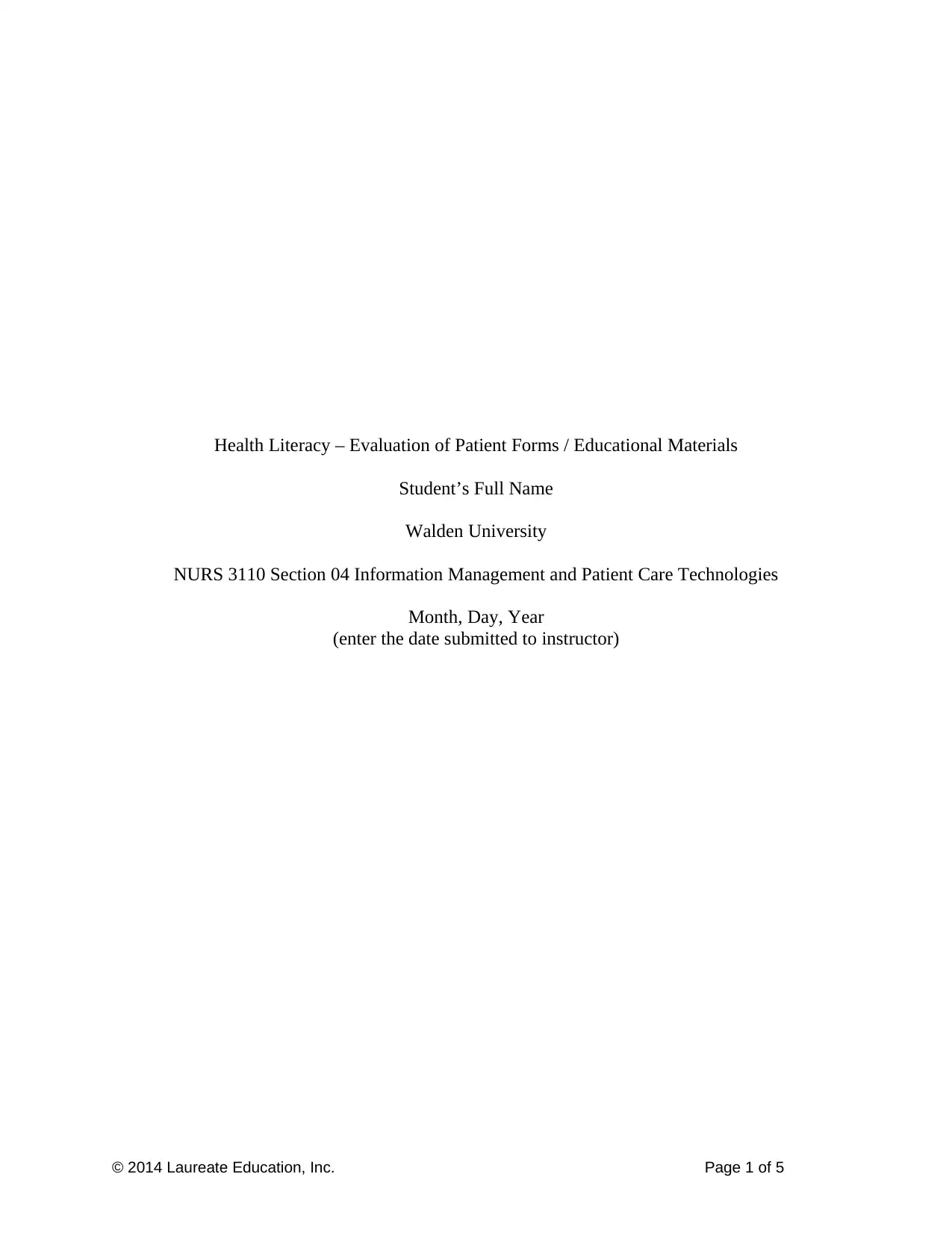
Health Literacy – Evaluation of Patient Forms / Educational Materials
Student’s Full Name
Walden University
NURS 3110 Section 04 Information Management and Patient Care Technologies
Month, Day, Year
(enter the date submitted to instructor)
© 2014 Laureate Education, Inc. Page 1 of 5
Student’s Full Name
Walden University
NURS 3110 Section 04 Information Management and Patient Care Technologies
Month, Day, Year
(enter the date submitted to instructor)
© 2014 Laureate Education, Inc. Page 1 of 5
Paraphrase This Document
Need a fresh take? Get an instant paraphrase of this document with our AI Paraphraser
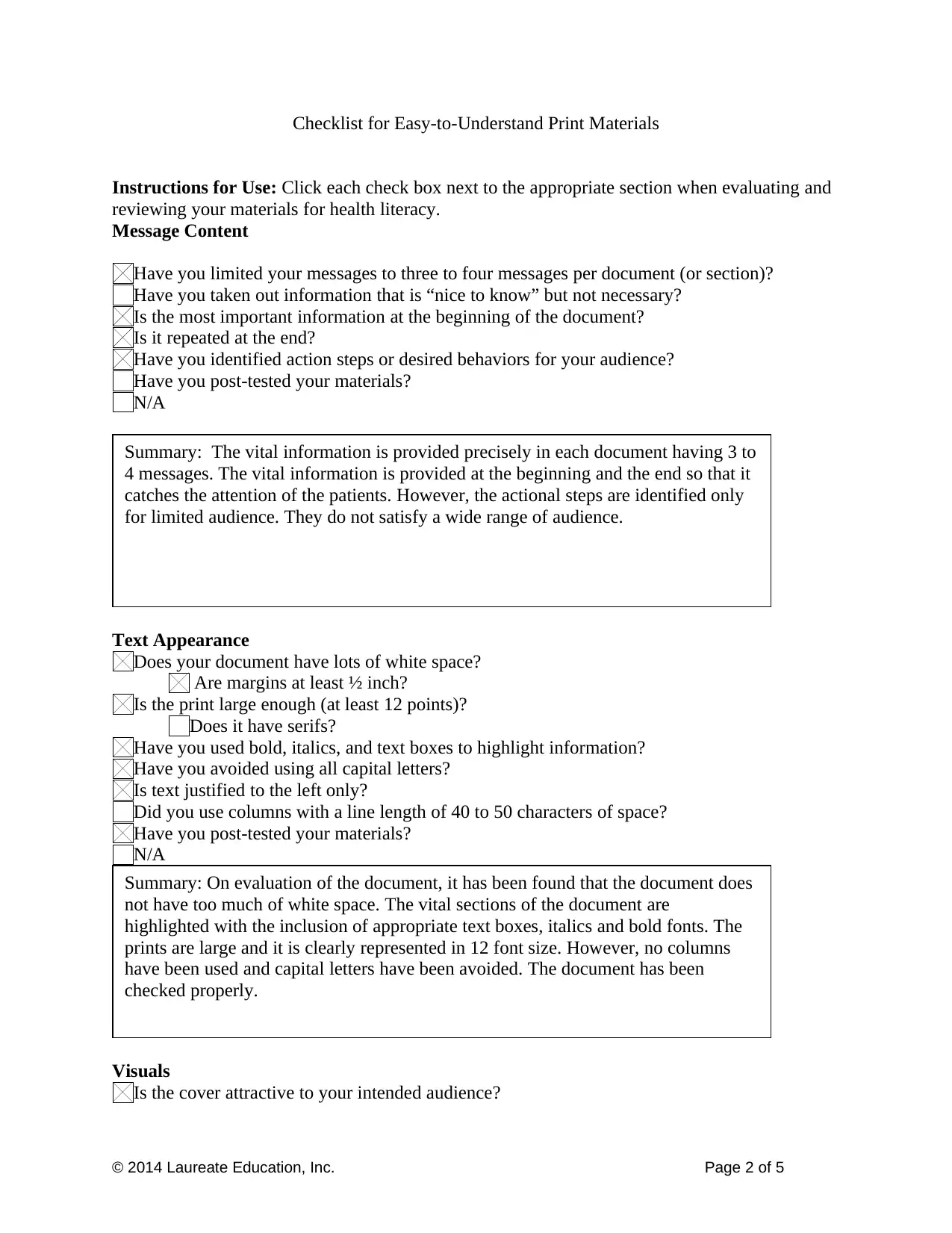
Checklist for Easy-to-Understand Print Materials
Instructions for Use: Click each check box next to the appropriate section when evaluating and
reviewing your materials for health literacy.
Message Content
Have you limited your messages to three to four messages per document (or section)?
Have you taken out information that is “nice to know” but not necessary?
Is the most important information at the beginning of the document?
Is it repeated at the end?
Have you identified action steps or desired behaviors for your audience?
Have you post-tested your materials?
N/A
Summary: The vital information is provided precisely in each document having 3 to
4 messages. The vital information is provided at the beginning and the end so that it
catches the attention of the patients. However, the actional steps are identified only
for limited audience. They do not satisfy a wide range of audience.
Text Appearance
Does your document have lots of white space?
Are margins at least ½ inch?
Is the print large enough (at least 12 points)?
Does it have serifs?
Have you used bold, italics, and text boxes to highlight information?
Have you avoided using all capital letters?
Is text justified to the left only?
Did you use columns with a line length of 40 to 50 characters of space?
Have you post-tested your materials?
N/A
Summary: On evaluation of the document, it has been found that the document does
not have too much of white space. The vital sections of the document are
highlighted with the inclusion of appropriate text boxes, italics and bold fonts. The
prints are large and it is clearly represented in 12 font size. However, no columns
have been used and capital letters have been avoided. The document has been
checked properly.
Visuals
Is the cover attractive to your intended audience?
© 2014 Laureate Education, Inc. Page 2 of 5
Instructions for Use: Click each check box next to the appropriate section when evaluating and
reviewing your materials for health literacy.
Message Content
Have you limited your messages to three to four messages per document (or section)?
Have you taken out information that is “nice to know” but not necessary?
Is the most important information at the beginning of the document?
Is it repeated at the end?
Have you identified action steps or desired behaviors for your audience?
Have you post-tested your materials?
N/A
Summary: The vital information is provided precisely in each document having 3 to
4 messages. The vital information is provided at the beginning and the end so that it
catches the attention of the patients. However, the actional steps are identified only
for limited audience. They do not satisfy a wide range of audience.
Text Appearance
Does your document have lots of white space?
Are margins at least ½ inch?
Is the print large enough (at least 12 points)?
Does it have serifs?
Have you used bold, italics, and text boxes to highlight information?
Have you avoided using all capital letters?
Is text justified to the left only?
Did you use columns with a line length of 40 to 50 characters of space?
Have you post-tested your materials?
N/A
Summary: On evaluation of the document, it has been found that the document does
not have too much of white space. The vital sections of the document are
highlighted with the inclusion of appropriate text boxes, italics and bold fonts. The
prints are large and it is clearly represented in 12 font size. However, no columns
have been used and capital letters have been avoided. The document has been
checked properly.
Visuals
Is the cover attractive to your intended audience?
© 2014 Laureate Education, Inc. Page 2 of 5
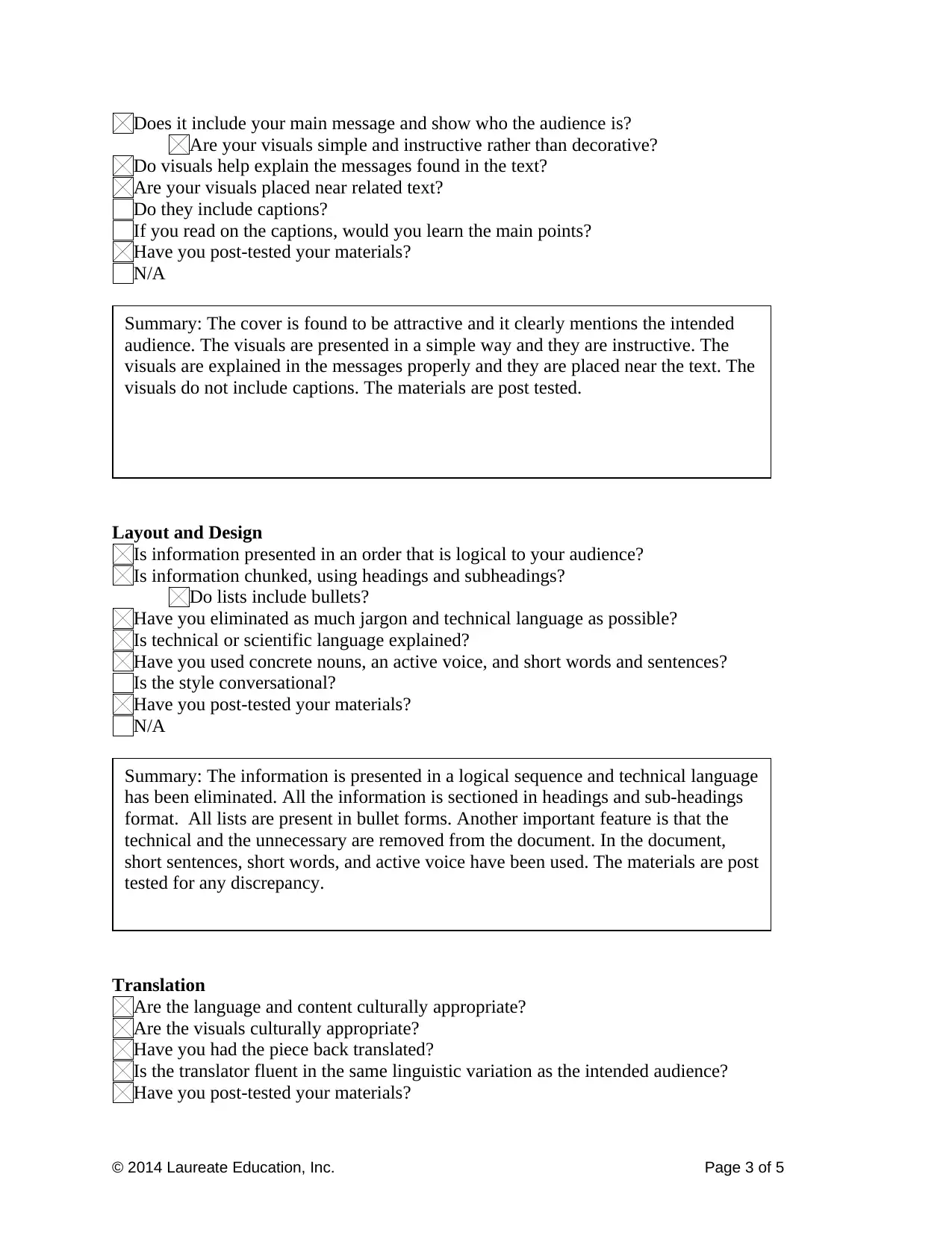
Does it include your main message and show who the audience is?
Are your visuals simple and instructive rather than decorative?
Do visuals help explain the messages found in the text?
Are your visuals placed near related text?
Do they include captions?
If you read on the captions, would you learn the main points?
Have you post-tested your materials?
N/A
Summary: The cover is found to be attractive and it clearly mentions the intended
audience. The visuals are presented in a simple way and they are instructive. The
visuals are explained in the messages properly and they are placed near the text. The
visuals do not include captions. The materials are post tested.
Layout and Design
Is information presented in an order that is logical to your audience?
Is information chunked, using headings and subheadings?
Do lists include bullets?
Have you eliminated as much jargon and technical language as possible?
Is technical or scientific language explained?
Have you used concrete nouns, an active voice, and short words and sentences?
Is the style conversational?
Have you post-tested your materials?
N/A
Summary: The information is presented in a logical sequence and technical language
has been eliminated. All the information is sectioned in headings and sub-headings
format. All lists are present in bullet forms. Another important feature is that the
technical and the unnecessary are removed from the document. In the document,
short sentences, short words, and active voice have been used. The materials are post
tested for any discrepancy.
Translation
Are the language and content culturally appropriate?
Are the visuals culturally appropriate?
Have you had the piece back translated?
Is the translator fluent in the same linguistic variation as the intended audience?
Have you post-tested your materials?
© 2014 Laureate Education, Inc. Page 3 of 5
Are your visuals simple and instructive rather than decorative?
Do visuals help explain the messages found in the text?
Are your visuals placed near related text?
Do they include captions?
If you read on the captions, would you learn the main points?
Have you post-tested your materials?
N/A
Summary: The cover is found to be attractive and it clearly mentions the intended
audience. The visuals are presented in a simple way and they are instructive. The
visuals are explained in the messages properly and they are placed near the text. The
visuals do not include captions. The materials are post tested.
Layout and Design
Is information presented in an order that is logical to your audience?
Is information chunked, using headings and subheadings?
Do lists include bullets?
Have you eliminated as much jargon and technical language as possible?
Is technical or scientific language explained?
Have you used concrete nouns, an active voice, and short words and sentences?
Is the style conversational?
Have you post-tested your materials?
N/A
Summary: The information is presented in a logical sequence and technical language
has been eliminated. All the information is sectioned in headings and sub-headings
format. All lists are present in bullet forms. Another important feature is that the
technical and the unnecessary are removed from the document. In the document,
short sentences, short words, and active voice have been used. The materials are post
tested for any discrepancy.
Translation
Are the language and content culturally appropriate?
Are the visuals culturally appropriate?
Have you had the piece back translated?
Is the translator fluent in the same linguistic variation as the intended audience?
Have you post-tested your materials?
© 2014 Laureate Education, Inc. Page 3 of 5
⊘ This is a preview!⊘
Do you want full access?
Subscribe today to unlock all pages.

Trusted by 1+ million students worldwide
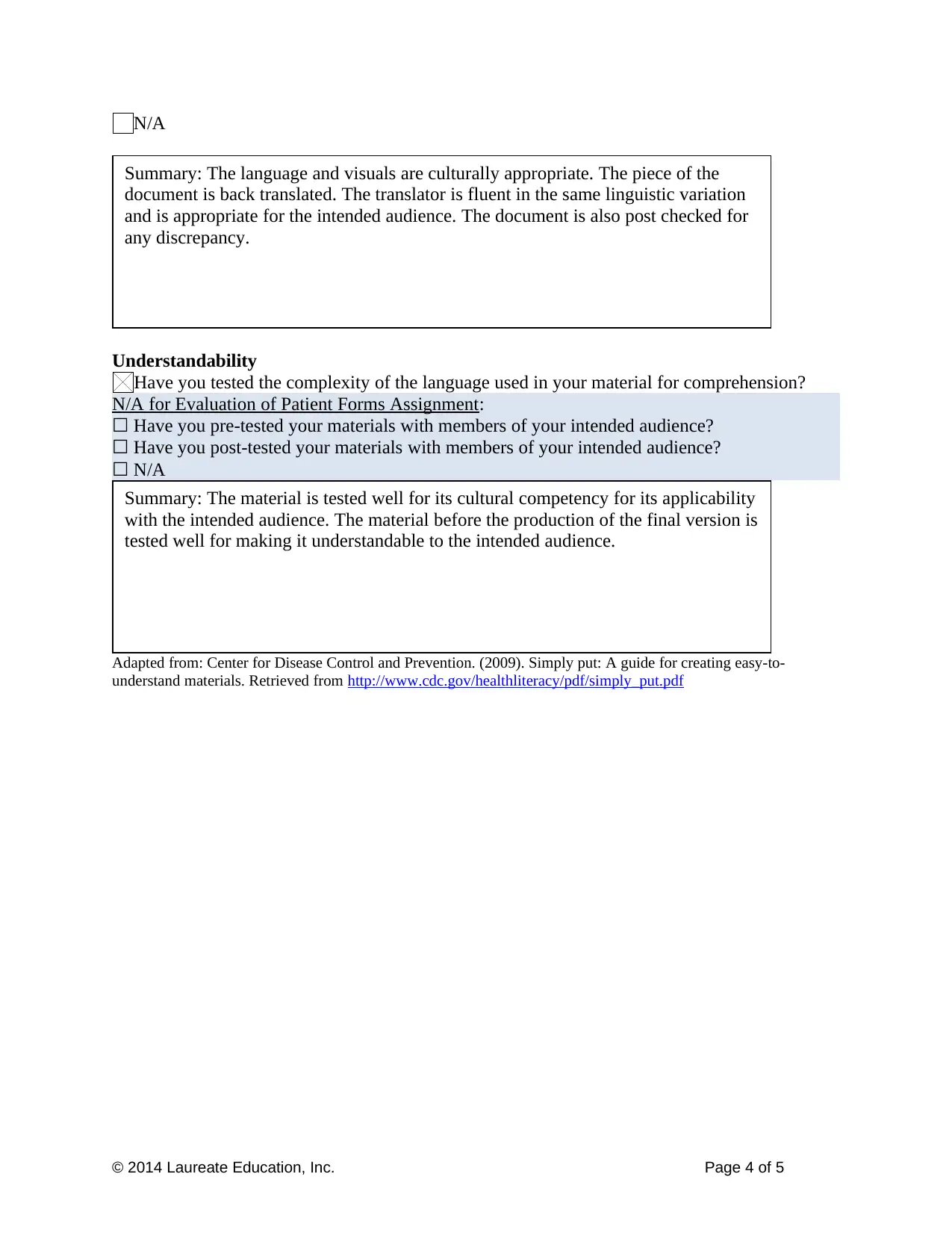
N/A
Summary: The language and visuals are culturally appropriate. The piece of the
document is back translated. The translator is fluent in the same linguistic variation
and is appropriate for the intended audience. The document is also post checked for
any discrepancy.
Understandability
Have you tested the complexity of the language used in your material for comprehension?
N/A for Evaluation of Patient Forms Assignment:
☐ Have you pre-tested your materials with members of your intended audience?
☐ Have you post-tested your materials with members of your intended audience?
☐ N/A
Summary: The material is tested well for its cultural competency for its applicability
with the intended audience. The material before the production of the final version is
tested well for making it understandable to the intended audience.
Adapted from: Center for Disease Control and Prevention. (2009). Simply put: A guide for creating easy-to-
understand materials. Retrieved from http://www.cdc.gov/healthliteracy/pdf/simply_put.pdf
© 2014 Laureate Education, Inc. Page 4 of 5
Summary: The language and visuals are culturally appropriate. The piece of the
document is back translated. The translator is fluent in the same linguistic variation
and is appropriate for the intended audience. The document is also post checked for
any discrepancy.
Understandability
Have you tested the complexity of the language used in your material for comprehension?
N/A for Evaluation of Patient Forms Assignment:
☐ Have you pre-tested your materials with members of your intended audience?
☐ Have you post-tested your materials with members of your intended audience?
☐ N/A
Summary: The material is tested well for its cultural competency for its applicability
with the intended audience. The material before the production of the final version is
tested well for making it understandable to the intended audience.
Adapted from: Center for Disease Control and Prevention. (2009). Simply put: A guide for creating easy-to-
understand materials. Retrieved from http://www.cdc.gov/healthliteracy/pdf/simply_put.pdf
© 2014 Laureate Education, Inc. Page 4 of 5
Paraphrase This Document
Need a fresh take? Get an instant paraphrase of this document with our AI Paraphraser
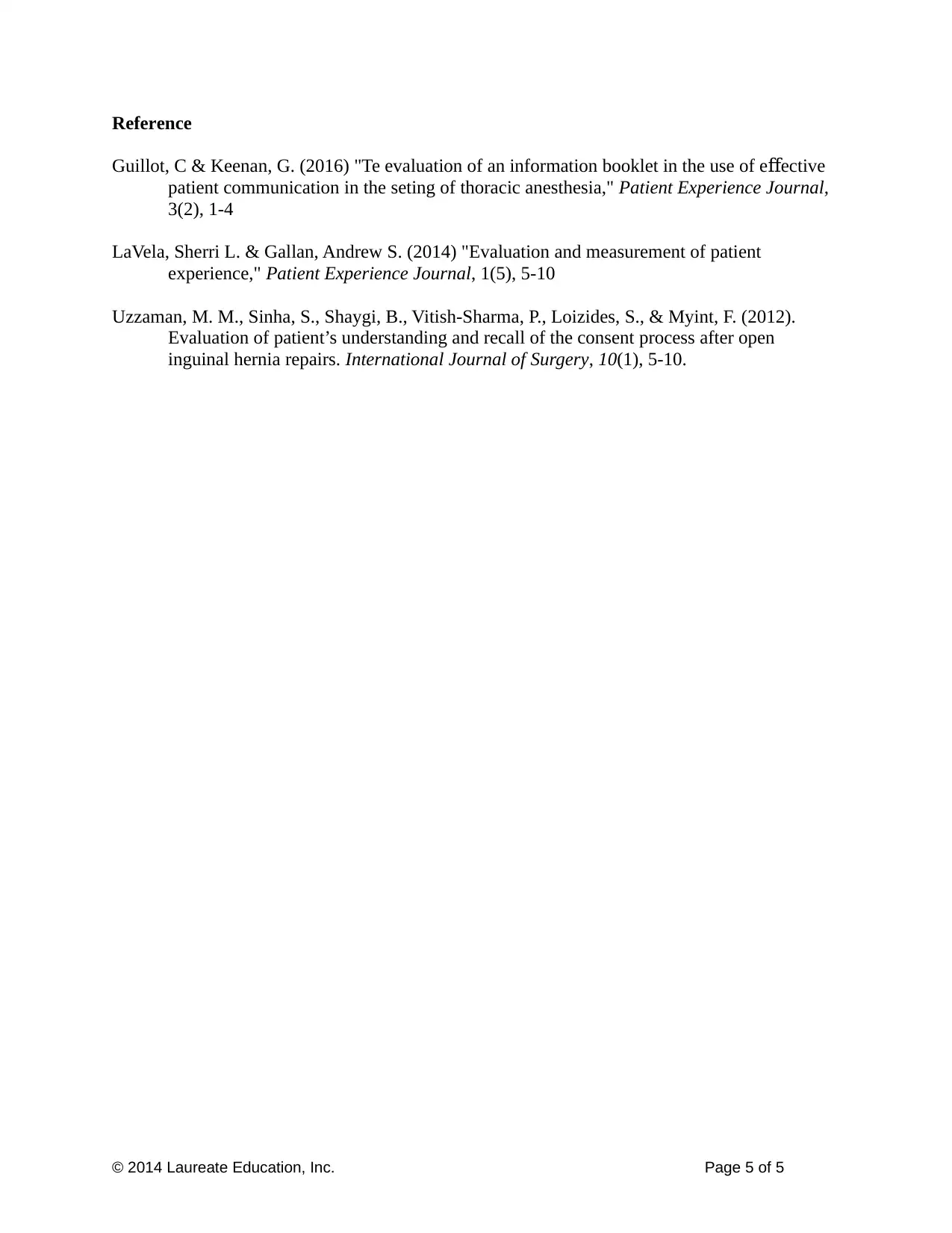
Reference
Guillot, C & Keenan, G. (2016) "Te evaluation of an information booklet in the use of e ectiveff
patient communication in the seting of thoracic anesthesia," Patient Experience Journal,
3(2), 1-4
LaVela, Sherri L. & Gallan, Andrew S. (2014) "Evaluation and measurement of patient
experience," Patient Experience Journal, 1(5), 5-10
Uzzaman, M. M., Sinha, S., Shaygi, B., Vitish-Sharma, P., Loizides, S., & Myint, F. (2012).
Evaluation of patient’s understanding and recall of the consent process after open
inguinal hernia repairs. International Journal of Surgery, 10(1), 5-10.
© 2014 Laureate Education, Inc. Page 5 of 5
Guillot, C & Keenan, G. (2016) "Te evaluation of an information booklet in the use of e ectiveff
patient communication in the seting of thoracic anesthesia," Patient Experience Journal,
3(2), 1-4
LaVela, Sherri L. & Gallan, Andrew S. (2014) "Evaluation and measurement of patient
experience," Patient Experience Journal, 1(5), 5-10
Uzzaman, M. M., Sinha, S., Shaygi, B., Vitish-Sharma, P., Loizides, S., & Myint, F. (2012).
Evaluation of patient’s understanding and recall of the consent process after open
inguinal hernia repairs. International Journal of Surgery, 10(1), 5-10.
© 2014 Laureate Education, Inc. Page 5 of 5
1 out of 5
Related Documents
Your All-in-One AI-Powered Toolkit for Academic Success.
+13062052269
info@desklib.com
Available 24*7 on WhatsApp / Email
![[object Object]](/_next/static/media/star-bottom.7253800d.svg)
Unlock your academic potential
Copyright © 2020–2025 A2Z Services. All Rights Reserved. Developed and managed by ZUCOL.





